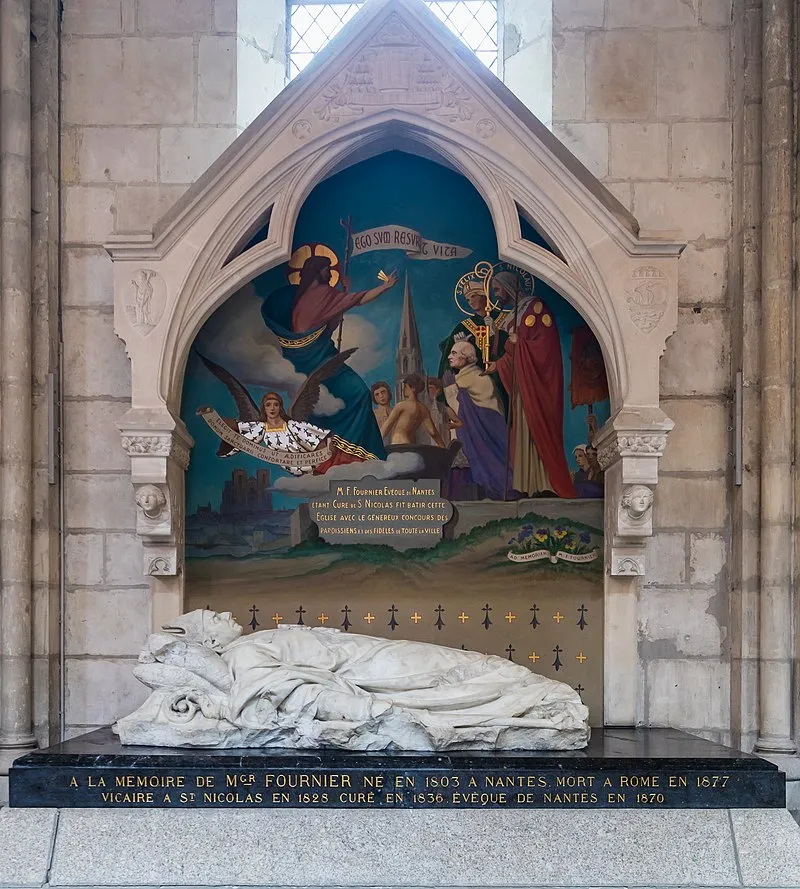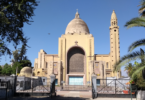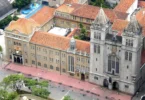Introduction

The Basilica of Saint Nicholas (French: Basilique Saint-Nicolas de Nantes) is a minor basilica in Nantes, Loire-Atlantique, historically in Brittany. The present church is a Gothic Revival structure built during the years 1844 to 1869 on the site of a mediaeval parish church largely rebuilt in the late 18th century. Because of the constrained site in the centre of the old city, the church is oriented north-south rather than the traditional east-west.The building was severely damaged in World War II in the Allied bombardment of 16 September 1943.Structural repairs were not completed until 1978.It was declared a minor basilica by Pope Leo XIII on 26 October 1882.The Gothic Revival furnishings were registered as a monument historique on 20 November 1985, the church itself on 6 November 1986.

The First Church
A chapel or small subsidiary church was constructed between the second half of the 11th century and the end of the 12th century. In the 18th century, the priest, theologian, and historian Nicolas Travers postulated the existence of a construction before 1186, citing the mention of a “St. Nicolas cemetery” in that year. At that time, the area was part of the Similien of Nantes parish. In 1226, Peter I of Brittany initiated the construction of an enclosure that encompassed the St. Nicolas neighborhood.
15th Century Extension
In the early 15th century, the fortifications had deteriorated to such an extent that Duke Francis I was prompted to undertake a program of renovation and reconstruction. This included the rebuilding of the St. Nicolas gate, situated at the junction of present-day Arche-Sèche and Commandant-Boulay streets. During this period, the St. Nicolas church also underwent renovations. Its name was first mentioned in a document dated 1444, which certified the work on the building’s portal by Mathurin Rodier. Rodier was also responsible for the reconstruction of the nearby St. Nicolas gate. The church was situated at the heart of a parish bearing its name.
From 1450 onward, the Church underwent a series of expansions that coincided with a notable increase in the parish’s population. The Fabric Council resolved to procure some properties, including a residence owned by Michel Botinat, a property belonging to the religious community of the Saint-Marie de Pornic convent, and another property owned by Jehan Rouxeau, a knight serving the Duke of Brittany. Consequently, plots of land were purchased to create a separation between the structure and the curtain wall. The nave of the church was then constructed on a portion of the ancient wall erected by Peter I, which still exists today in the form of remnants visible on Duvoisin Street ,situated along the western side of the current church. The successive extensions were such that they justified a new inauguration, conducted by Bishop Pierre of Chaffault on 24 February 1478. Two notable features of the building were a 20-meter-high stained glass window and an altar adorned with 26 statues.
17th and 18th Centuries
In the mid-17th century, the bell tower was in a state of disrepair and was at risk of collapsing. A fundraising campaign was initiated, which included the sale of valuable liturgical books. The restoration work commenced in 1766 and was concluded in 1772.However, the parish had a more ambitious vision, namely the complete reconstruction of the building. The initial plans were drafted as early as 1773, and the decision to proceed with the reconstruction was made in 1789. The renovation that spanned from 1766 to 1772 thus marked the final modification to the existing structure, which featured three naves separated by a substantial pillar. The chevet was flat, with the apse situated at the current Affre Street , accessible from the south via Place Félix-Fournier . The main entrance was from the south, via a porch located at the current Félix-Fournier Square. The church retained its monumental stained glass window and ornate altar.
Architecture of Basilica of Saint Nicholas of Nantes, France

The New Building
Under the impetus of Félix Fournier, parish priest and future bishop of Nantes, the construction of the current church spanned from 1844 (laying of the foundation stone) to 1869 (blessing of the building) on a narrow plot that required it to be oriented on a north-south axis, rather than the traditional east-west Christian orientation (sun rising on the sanctuary). The construction of the bell tower alone occupied the last fifteen years of the work. A commemorative medal celebrated the laying of the foundation stone of the new church, during the reign of Louis-Philippe, under the administration of Prefect Achille Chaper and Mayor Ferdinand Favre .The church was built with regional granite, as well as hard stones and tuffeau from Touraine. The project was entrusted to Jean-Baptiste-Antoine Lassus, a student of Henri Labrouste and collaborator of Eugène Viollet-le-Duc, who, along with Piel made it one of the very first neo-Gothic projects in France.It was raised to the status of a minor basilica on 26 October 1882, by Pope Leo XIII. The tomb of Félix Fournier, who died in 1877, was installed in 1883.
The neo-Gothic furniture was listed as a historical monument on 20 November 1985, a year before the church itself was classified on 6 November 1986.
Damage and Reconstruction
The church sustained significant damage as a result of the Allied bombing campaign on 16 September 1943. This had a considerable impact on the surrounding area, including parts of the Place Royale and the Rue du Calvaire, which runs along the northern side of the latter. Paul Caillaud, director of Nantes’ passive defense, indicated that the church sustained significant damage along its ambulatory route on Rue Affre, close to the bell tower, which was fortunately spared. Two vault ribs were dislodged. It appears that an anti-aircraft shell or a small bomb fell perpendicularly or exploded on the ground. Subsequently, other bombs entered obliquely and caused the arches and enclosure walls to open, partially dislodged the organ’s woodwork, and caused the floor to collapse. The tomb of Bishop Fournier, a substantial marble base, was damaged. Following the conclusion of hostilities, the reconstruction project commenced in 1953 and continued until 1974. The damaged organ, constructed in 1901, was dismantled but subsequently rebuilt in two phases: in 1963 and 1985.
The exterior stone was significantly degraded by air pollution during the 20th century, necessitating a comprehensive restoration project initiated in 2004 under the direction of Pascal Prunet, chief architect of Historical Monuments . The project entailed the restoration of the tuffeau and granite, as well as the complete refurbishment of severely damaged exterior elements.
Bells

The bell tower contains a set of five swinging bells, cast in 1882 by Adhémar Astier, a bell founder in Nantes.
- The voice of God in its strength (bourdon): E2 – 7,270 kg
- Anne-Joséphine-Aimée: A2 – 2,896 kg
- Louise-Anne-Cécile: B – 2,031 kg
- Joséphine-Elisabeth-Louise: C#3 – 1,451 kg
- Céleste: E3 – 876 kg
The bourdon is among the ten bells in France with the deepest sound. Its note (E2) is lower than that of the bourdon of Notre-Dame de Paris.
Feast Day
Feast day: December 6
The annual feast day of Basilica of Saint Nicholas of Nantes, Nantes, France, is celebrated on December 6 each year.
Church Mass Timing
Monday : 7:00 p.m.
Tuesday : 7:15 a.m. – 7:00 p.m.
Wednesday : 7:15 a.m. – 7:00 p.m.
Thursday : 7:15 a.m. – 7:00 p.m.
Friday : 7:15 a.m. – 7:00 p.m.
Saturday : 6:00 p.m.
Sunday : 10:00 a.m. – 6:00 p.m.
Church Opening Time:
Monday : 7:00 am – 7:30 pm
Tuesday : 7:00 am – 7:30 pm
Wednesday : 7:00 am – 7:30 pm
Thursday : 7:00 am – 7:30 pm
Friday : 7:00 am – 7:30 pm
Saturday : 9:00 am – 7:00 pm
Sunday : 9:30 am – 7:30 pm
Contact Info
Address :
Pl. Félix Fournier, 44000 Nantes, France.
Phone : +33240481994
Accommodations
Connectivities
Airway
Saint Nicholas of Nantes, Nantes, France church is Nantes Atlantique Airport (NTE) distance between 23 min (15.1 km) via N844.
Railway
Saint Nicholas of Nantes in France church is Nantes’ main railway station distance is 8 min (1.8 km) via Rue de Strasbourg.








